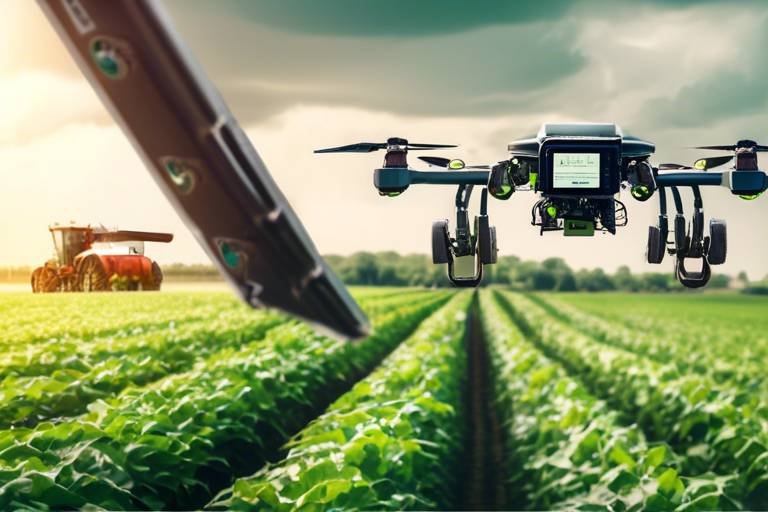Major AI Innovations in the Journalism World
In today's fast-paced digital landscape, the world of journalism is undergoing a remarkable transformation, largely driven by the advancements in artificial intelligence (AI). These innovations are not just mere enhancements; they are fundamentally reshaping how news is created, reported, and consumed. Imagine a newsroom where algorithms assist journalists in crafting stories, analyzing data, and even predicting what readers want to know next. This is not a futuristic dream; it’s happening right now. AI is enabling journalists to focus on the core of their craft—telling compelling stories—while machines handle the more mundane tasks. This article delves into the significant AI innovations that are revolutionizing journalism, enhancing content creation, and changing the dynamics of news reporting.
One of the most exciting developments in AI is the rise of automated content generation. With sophisticated algorithms, AI tools are now capable of producing news articles and reports automatically. This means that journalists can dedicate their time to more in-depth analysis and creative storytelling. For instance, during breaking news events, AI can quickly generate reports based on real-time data, ensuring that the public receives timely updates. Think of it as a well-oiled machine that churns out the facts while human reporters dive deeper into the nuances of the story. This synergy allows for a richer, more engaging news experience.
The integration of AI in data journalism is another game-changer. Journalists are now able to analyze vast datasets in a fraction of the time it would take manually. This capability helps uncover trends, patterns, and insights that inform stories and enhance the overall quality of reporting. For example, AI can sift through millions of social media posts to identify emerging topics of interest, allowing news outlets to stay ahead of the curve. By leveraging data analytics, journalists can provide their audiences with stories that are not only timely but also relevant and impactful.
One of the most fascinating aspects of data journalism is predictive analytics. By utilizing AI algorithms, news organizations can forecast trends and audience interests. This means they can tailor their content strategies to better engage readers. Imagine being able to predict which stories will resonate with your audience before they even hit the newsstands! This predictive power allows media outlets to create content that aligns with reader preferences, ultimately enhancing engagement and retention.
With AI-driven audience targeting, media outlets can personalize content delivery like never before. This technology ensures that readers receive news that aligns with their interests, making for a more engaging experience. For instance, if a reader frequently interacts with articles about technology, AI can prioritize tech-related content in their feed. This level of personalization not only increases reader satisfaction but also fosters a deeper connection between the audience and the news organization.
AI tools can also analyze reader engagement metrics to optimize various aspects of content, such as headlines, images, and formats. By understanding what captures attention and drives clicks, journalists can enhance the overall effectiveness of their articles. For example, AI can suggest more compelling headlines or identify the ideal time to publish a story based on audience behavior. This optimization process increases visibility across platforms, ensuring that quality journalism reaches as many readers as possible.
In an age where misinformation can spread like wildfire, AI technologies are revolutionizing the fact-checking process. Journalists can now verify information quickly and accurately, which significantly increases the credibility and reliability of news reporting. AI tools can cross-reference claims with reputable sources and flag inconsistencies in real time. This not only helps maintain journalistic integrity but also empowers readers to trust the news they consume.
As AI continues to play a significant role in journalism, ethical concerns arise that warrant careful examination. Issues such as bias, misinformation, and the potential for job displacement are at the forefront of discussions about AI's impact on the industry. It’s crucial for journalists and media organizations to navigate these challenges thoughtfully to ensure that the benefits of AI do not come at the cost of ethical standards.
The presence of bias in AI algorithms can lead to skewed reporting and reinforce stereotypes. This highlights the urgent need for transparency and fairness in AI development within journalism. If the data fed into these algorithms is biased, the output will be too. Therefore, it’s essential for media organizations to actively monitor and adjust their AI systems to promote equitable representation in news coverage.
Another pressing concern is the potential for job displacement among journalists. As AI takes on more tasks traditionally handled by humans, discussions about the future of the profession become increasingly relevant. While AI can enhance productivity and efficiency, it’s vital to consider what this means for the role of human reporters. Rather than viewing AI as a replacement, it should be seen as a tool that can augment human creativity and insight in storytelling.
Looking ahead, the future of AI in journalism promises even more groundbreaking innovations. We can expect enhanced storytelling techniques, improved user engagement, and the potential for immersive news experiences that redefine how audiences consume information. Imagine a world where virtual reality brings news stories to life, or where AI curates personalized news experiences tailored to individual preferences. The possibilities are endless, and the journey has only just begun.
- How is AI changing journalism? AI is automating content generation, enhancing data analysis, and improving audience targeting, allowing journalists to focus on storytelling.
- What are the ethical concerns surrounding AI in journalism? Ethical concerns include bias in algorithms, misinformation, and potential job displacement for journalists.
- Can AI replace journalists? While AI can assist in many tasks, it is unlikely to fully replace journalists, as human creativity and insight are essential in storytelling.
- What is predictive analytics in journalism? Predictive analytics uses AI to forecast trends and audience interests, helping news organizations tailor their content strategies.

Automated Content Generation
In today's fast-paced world, is revolutionizing how news is produced and consumed. Imagine a scenario where breaking news is reported within minutes, or even seconds, thanks to sophisticated AI tools that can churn out articles with remarkable speed and accuracy. These tools are not just about speed; they also enable journalists to focus on what they do best—crafting compelling narratives and conducting thorough investigations. This shift allows for a more dynamic approach to storytelling, where the mundane task of writing basic news reports can be automated, freeing up human reporters to delve deeper into the stories that matter.
AI-driven platforms like Wordsmith and Quill have emerged as pioneers in this field, utilizing natural language generation (NLG) to create articles that are not only informative but also engaging. These platforms analyze data, recognize patterns, and generate narratives that resemble human writing. For instance, during a major sports event, AI can quickly compile statistics, player performances, and match outcomes to produce a comprehensive report within moments of the final whistle. This not only enhances the speed of reporting but also ensures that audiences stay informed in real-time.
Moreover, the integration of AI in content generation is not limited to just news articles. It extends to various forms of content, including social media posts, blog entries, and even video scripts. By leveraging AI, media companies can ensure consistent and timely content delivery, which is crucial in an era where information is consumed across multiple platforms. The ability to automate content generation also allows for personalization; AI can analyze user preferences and tailor content to suit individual tastes, making news consumption a more engaging experience.
However, while the benefits of automated content generation are clear, it is important to recognize the potential challenges it poses. For instance, there are concerns about the quality and depth of AI-generated content. Although AI can produce articles quickly, it may lack the nuanced understanding and emotional intelligence that human journalists bring to their work. This raises questions about the credibility of automated reporting and whether it can truly replace the insights and perspectives offered by seasoned reporters.
In conclusion, automated content generation is a game-changer for the journalism industry. It enhances efficiency, allows for real-time updates, and personalizes content for readers. As we continue to embrace these technological advancements, it is crucial to strike a balance between automation and the invaluable contributions of human journalists. By doing so, we can create a future where AI and human creativity coexist, ultimately enriching the journalism landscape.
- What is automated content generation? Automated content generation refers to the use of AI tools and algorithms to create news articles and reports without human intervention.
- How does AI improve journalism? AI enhances journalism by allowing for faster reporting, data analysis, and personalized content delivery, freeing journalists to focus on in-depth storytelling.
- Are AI-generated articles reliable? While AI can produce articles quickly, the reliability of the content depends on the quality of the data and algorithms used. Human oversight is essential to ensure accuracy and depth.
- Will AI replace journalists? AI is unlikely to completely replace journalists; rather, it will change the nature of their work, allowing them to focus on more complex and creative tasks.

Data Journalism and Analytics
In the rapidly evolving landscape of journalism, the incorporation of artificial intelligence into data journalism has become a game-changer. Imagine a world where journalists can sift through mountains of data in a matter of seconds, uncovering hidden patterns and insights that would otherwise remain buried. This is the power of AI in data journalism, and it’s transforming how stories are told and reported. With AI tools at their disposal, journalists can now focus on crafting compelling narratives while allowing technology to handle the heavy lifting of data analysis.
One of the most significant advantages of AI in data journalism is its ability to process vast datasets quickly. Journalists can now analyze information from multiple sources, including social media, government databases, and public records, all at lightning speed. This capability not only enhances the quality of reporting but also ensures that stories are timely and relevant. For instance, during a breaking news event, AI can aggregate real-time data, providing journalists with the most current information to inform their reporting.
Furthermore, AI-driven analytics can uncover trends that might go unnoticed by the human eye. By employing sophisticated algorithms, journalists can identify shifts in public opinion, track emerging issues, and even predict future events based on historical data. This predictive capability is particularly valuable in a world where news cycles move at an unprecedented pace. Journalists can not only report on what’s happening now but also anticipate what might happen next, allowing them to stay one step ahead in their storytelling.
To illustrate the impact of data journalism and analytics, consider the following table that highlights how AI tools are being used in various aspects of journalism:
| AI Tool | Application | Benefit |
|---|---|---|
| Natural Language Processing (NLP) | Analyzing text data | Extracting insights from articles, reports, and social media posts |
| Machine Learning Algorithms | Identifying patterns | Uncovering trends in audience behavior and preferences |
| Data Visualization Tools | Presenting complex data | Making information accessible and engaging for readers |
Moreover, the integration of AI in data journalism has paved the way for collaborative storytelling. Journalists can work alongside data scientists and analysts to create more comprehensive reports. This collaboration not only enriches the storytelling process but also ensures that the data presented is accurate and meaningful. In essence, data journalism powered by AI is not just about numbers; it's about weaving those numbers into compelling narratives that resonate with audiences.
However, with great power comes great responsibility. As journalists embrace AI and data analytics, they must also be vigilant about the ethical implications. The potential for misinformation and misinterpretation of data can lead to serious consequences. Consequently, journalists must remain committed to verifying their sources and ensuring that their analyses are grounded in fact. The balance between utilizing AI's capabilities and maintaining journalistic integrity is crucial in this new era of reporting.
- What is data journalism? Data journalism is the practice of using data to tell stories, analyze trends, and provide insights that enhance traditional reporting.
- How does AI improve data journalism? AI enhances data journalism by enabling faster analysis of large datasets, uncovering trends, and providing predictive insights that inform reporting.
- What are the ethical concerns surrounding AI in journalism? Ethical concerns include bias in AI algorithms, the potential for misinformation, and the need for transparency in data reporting.
- Can AI replace journalists? While AI can automate certain tasks, it cannot replace the human touch in storytelling, creativity, and critical thinking that journalists provide.

Predictive Analytics
In the rapidly evolving landscape of journalism, has emerged as a game-changer, enabling news organizations to anticipate trends and understand audience preferences like never before. Imagine having a crystal ball that not only reveals what stories will capture public interest but also provides insights into how to present them for maximum impact. This is precisely what predictive analytics offers, leveraging AI algorithms to sift through mountains of data and extract actionable insights.
At its core, predictive analytics involves analyzing historical data to make informed predictions about future events. For journalists, this means they can identify emerging topics before they hit the mainstream, allowing them to create content that resonates with their audience. For instance, if data shows a rising interest in climate change discussions, a news outlet can prioritize related stories, ensuring they stay ahead of the curve. This proactive approach not only enhances the relevance of the content but also positions the outlet as a thought leader in the industry.
Moreover, predictive analytics can significantly improve reader engagement. By understanding what types of stories capture attention, news organizations can tailor their content strategies accordingly. This might involve analyzing metrics such as:
- Click-through rates
- Time spent on articles
- Social media shares
- Comments and feedback from readers
With these insights, journalists can craft articles that not only inform but also engage their audience, fostering a deeper connection with readers. For example, if data indicates that readers prefer in-depth analysis over quick summaries, journalists can adjust their writing style and content depth to cater to this preference.
Furthermore, predictive analytics can enhance advertising strategies. By understanding audience demographics and interests, news organizations can serve targeted ads that align with readers' preferences, increasing the likelihood of engagement and conversion. This symbiotic relationship between content and advertising ensures that both the news outlet and advertisers benefit, creating a more sustainable business model in an era where traditional revenue streams are dwindling.
However, it’s essential to note that while predictive analytics offers tremendous potential, it also comes with challenges. The reliance on data can sometimes lead to a lack of diversity in storytelling, as outlets may focus solely on what is trending rather than exploring underreported issues. Therefore, it’s crucial for journalists to balance data-driven insights with their editorial judgment, ensuring that the news remains comprehensive and varied.
In summary, predictive analytics is reshaping journalism by providing tools that allow for a more strategic approach to content creation. By harnessing the power of data, journalists can not only predict what stories will resonate but also optimize their delivery to maximize audience engagement. As we look to the future, the integration of predictive analytics in journalism promises to enhance the storytelling experience, making news more relevant and engaging for all.
- What is predictive analytics in journalism? Predictive analytics refers to the use of AI algorithms to analyze historical data and forecast future trends in audience interests and news topics.
- How does predictive analytics improve reader engagement? By understanding what types of stories resonate with audiences, journalists can tailor their content to meet reader preferences, leading to increased engagement.
- Can predictive analytics lead to biased reporting? Yes, if media outlets rely solely on data, they may overlook important stories that are not trending, leading to a lack of diversity in reporting.
- Is predictive analytics only beneficial for large news organizations? While larger organizations may have more resources to implement predictive analytics, smaller outlets can also leverage data tools to enhance their reporting strategies.

Audience Targeting
In today's fast-paced digital landscape, has become a game-changer for media outlets. Imagine being able to deliver news that feels tailor-made for each reader, resonating with their interests and preferences. This is precisely what AI-driven audience targeting achieves. By analyzing vast amounts of data, AI can identify patterns in reader behavior, enabling news organizations to create personalized content delivery systems. This means that instead of receiving a generic news feed, readers get updates that are relevant to their specific tastes, whether they're interested in politics, sports, or technology.
The technology behind audience targeting relies on sophisticated algorithms that track user interactions across different platforms. For instance, when a reader frequently engages with articles on environmental issues, AI can prioritize similar content in their feed. This not only enhances the reader's experience but also boosts engagement rates for news organizations. In essence, it’s like having a personal news assistant that curates the most pertinent stories just for you!
Furthermore, the implications of audience targeting extend beyond mere content delivery. It also allows media outlets to improve their advertising strategies. By understanding what content resonates with their audience, they can serve more relevant ads, thereby increasing click-through rates and generating higher revenue. This creates a win-win situation: readers receive content that interests them, and advertisers benefit from targeted exposure.
However, while the benefits are clear, there are also challenges that come with audience targeting. Privacy concerns loom large, as readers may feel uneasy about how their data is being used. Striking a balance between personalization and privacy is crucial. News organizations must be transparent about their data collection practices and ensure that readers have control over their information. This transparency not only builds trust but also fosters a loyal readership.
In conclusion, AI-driven audience targeting is revolutionizing how news is consumed. By providing personalized content and improving advertising strategies, it enhances the overall reader experience. As the technology continues to evolve, it will be fascinating to see how media outlets navigate the challenges of privacy while maximizing the benefits of targeted news delivery. The future of journalism may very well depend on how effectively they can harness this powerful tool.
- What is audience targeting in journalism? - Audience targeting in journalism refers to the use of AI and data analytics to deliver personalized content to readers based on their interests and preferences.
- How does AI improve audience targeting? - AI analyzes user behavior and engagement metrics to identify patterns, allowing news organizations to tailor content that resonates with specific audiences.
- Are there privacy concerns with audience targeting? - Yes, there are privacy concerns, as readers may be wary of how their data is collected and used. Transparency in data practices is essential to maintain trust.
- Can audience targeting benefit advertisers? - Absolutely! By serving more relevant ads aligned with reader interests, audience targeting can increase click-through rates and enhance advertising effectiveness.

Content Optimization
In the fast-paced world of journalism, has emerged as a crucial factor in ensuring that articles not only reach their intended audience but also resonate with them. Thanks to AI tools, journalists can now analyze reader engagement metrics in real-time, allowing them to make informed decisions about how to structure their articles for maximum impact. Imagine crafting a piece that not only informs but also captivates your readers, keeping them glued to the screen. This is where AI steps in, acting like a seasoned editor that knows exactly what the audience craves.
One of the most exciting aspects of content optimization is the ability of AI to analyze headlines, images, and even the overall format of articles. For instance, AI algorithms can assess which headlines attract more clicks and which images generate more shares on social media. This data-driven approach enables journalists to tailor their content to meet the preferences of their audience. If a certain type of headline consistently performs better, journalists can adjust their writing style accordingly, ensuring that their work remains relevant and engaging.
Moreover, AI can help in identifying the optimal length of articles. Studies have shown that readers have varying preferences when it comes to article length. Some prefer quick reads, while others enjoy in-depth analysis. By utilizing AI, journalists can determine the ideal word count for specific topics, leading to higher reader retention rates. This level of customization is akin to a chef adjusting a recipe based on the diners' tastes, ensuring that every dish served is a hit.
To illustrate the impact of content optimization further, let’s take a look at a simple table showcasing different article formats and their engagement rates:
| Article Format | Average Engagement Rate (%) |
|---|---|
| Listicles | 75 |
| In-Depth Features | 60 |
| Short News Updates | 50 |
| Opinion Pieces | 55 |
This table highlights how various formats can yield different engagement rates. By leveraging AI, journalists can pivot their strategies to focus on formats that resonate more with their audience, thereby enhancing their overall reach and effectiveness.
Furthermore, AI tools can assist in SEO optimization, ensuring that articles are not just well-written but also easily discoverable on search engines. By analyzing trending keywords and phrases, AI can suggest modifications that improve an article's visibility online. This means that a well-optimized article has a higher chance of appearing on the first page of search results, driving more traffic to the publication.
In conclusion, content optimization through AI is revolutionizing the journalism landscape. By providing insights into reader preferences and engagement metrics, AI empowers journalists to craft articles that are not only informative but also captivating. As we move forward, the synergy between human creativity and AI-driven analytics will undoubtedly shape the future of journalism, making it more responsive and engaging for readers.
- What is content optimization in journalism? Content optimization involves using data and analytics to enhance the effectiveness of articles, ensuring they engage readers and meet their preferences.
- How does AI help in content optimization? AI helps by analyzing reader engagement metrics, suggesting improvements for headlines, images, and article formats, and optimizing for SEO.
- Why is content optimization important? It's important because it increases reader engagement, retention, and visibility, ultimately leading to a more successful journalism practice.

Fact-Checking and Verification
In today's fast-paced digital landscape, where news travels at lightning speed, the importance of cannot be overstated. With the rise of social media and user-generated content, misinformation can spread like wildfire, often leading to confusion and distrust among the audience. This is where artificial intelligence steps in, revolutionizing the way journalists verify facts and ensure the integrity of their reporting.
AI technologies are equipped with advanced algorithms that can analyze vast amounts of information in mere seconds. This capability allows journalists to cross-reference facts against credible sources, significantly reducing the time it takes to verify information. Imagine a world where a journalist can confirm the accuracy of a statement while drafting an article, rather than spending hours sifting through data and sources. This not only enhances the speed of reporting but also elevates the overall quality of journalism.
One of the most significant advancements in AI for fact-checking is the use of natural language processing (NLP). NLP allows AI systems to understand and interpret human language, making it easier to identify claims that need verification. For instance, when a politician makes a statement during a speech, AI tools can instantly analyze the claim, search for relevant data, and provide context to the journalist. This ensures that the final article is not only accurate but also rich in context, allowing readers to grasp the nuances of the story.
Moreover, AI can assist in identifying patterns of misinformation. By analyzing historical data, AI systems can recognize recurring themes or sources that frequently propagate false information. This proactive approach empowers journalists to be more vigilant and discerning about the information they choose to report. It’s like having a digital watchdog that alerts you whenever a familiar source of misinformation is on the rise, helping to maintain the credibility of the news.
However, while AI is a powerful ally in the quest for truth, it is essential to remember that it is not infallible. The algorithms that drive these technologies can sometimes inherit biases from the data they are trained on, which can lead to inaccuracies. Therefore, it is crucial for journalists to remain engaged in the verification process, using AI as a tool rather than a crutch. The human touch is irreplaceable, especially when it comes to understanding context, nuance, and the ethical implications of reporting.
In summary, the integration of AI in fact-checking and verification processes marks a significant leap forward for journalism. By enhancing the speed and accuracy of information verification, AI tools allow journalists to focus on what they do best: storytelling. As we continue to navigate the complexities of the digital age, the collaboration between human intuition and AI technology will be vital in upholding the standards of journalism.
- What is the role of AI in fact-checking? AI helps journalists verify information quickly by analyzing data and cross-referencing claims against credible sources.
- Can AI completely replace human fact-checkers? No, while AI can assist in the verification process, human judgment is essential for understanding context and nuance.
- What are the risks associated with AI in journalism? Potential risks include algorithmic bias and the spread of misinformation if AI systems are not properly managed.
- How does natural language processing (NLP) aid in fact-checking? NLP allows AI to understand human language, making it easier to identify claims that require verification.

Ethical Considerations in AI Journalism
As artificial intelligence (AI) continues to weave itself into the fabric of journalism, it brings with it a host of ethical considerations that cannot be ignored. The rise of AI technologies in newsrooms has sparked discussions about the implications of using algorithms to generate content, analyze data, and even interact with audiences. One of the most pressing issues is the potential for bias in AI algorithms, which can lead to skewed reporting and reinforce harmful stereotypes. This bias often stems from the data sets used to train these algorithms, which may reflect societal prejudices or incomplete information.
Moreover, the reliance on AI for content generation raises questions about accountability. Who is responsible when an AI-generated article spreads misinformation? Is it the developers of the AI, the journalists who use it, or the media outlets themselves? These questions highlight the need for transparency in AI development and implementation within journalism. It's crucial for news organizations to establish guidelines that ensure ethical use of AI, fostering an environment where accuracy and credibility are prioritized.
Another significant concern is the potential for job displacement among journalists. As AI tools become more sophisticated in generating content, many fear that traditional reporting roles may diminish. While AI can handle routine tasks, such as writing basic news reports or summarizing data, it lacks the human touch that is essential for in-depth storytelling and investigative journalism. The challenge lies in finding a balance where AI serves as a tool to enhance journalistic efforts rather than replace them. This evolution may require journalists to adapt their skills, embracing AI as a partner in their work rather than a competitor.
In light of these concerns, it’s essential for journalists and media organizations to engage in ongoing discussions about the ethical implications of AI. Establishing a framework for ethical AI use in journalism could involve:
- Implementing rigorous testing for biases in AI algorithms
- Creating transparent reporting standards for AI-generated content
- Ensuring that human oversight remains a critical component of the news production process
- Encouraging continuous education for journalists on AI technologies and their implications
By prioritizing these ethical considerations, the journalism industry can harness the power of AI while safeguarding its core values of truth, fairness, and integrity. As we navigate this evolving landscape, it’s vital to remember that technology should enhance our ability to tell stories, not compromise the principles that define quality journalism.
Q1: What are the main ethical issues related to AI in journalism?
A1: The primary ethical issues include bias in AI algorithms, accountability for misinformation, and the potential for job displacement among journalists.
Q2: How can bias in AI algorithms affect journalism?
A2: Bias in AI can lead to skewed reporting and the reinforcement of stereotypes, which can misinform audiences and damage the credibility of news organizations.
Q3: Will AI replace journalists?
A3: While AI can automate certain tasks, it is unlikely to fully replace journalists. Instead, it should be viewed as a tool that can enhance journalistic efforts.
Q4: What steps can journalists take to ensure ethical AI use?
A4: Journalists can advocate for transparency in AI algorithms, engage in discussions about ethical standards, and continue to educate themselves about AI technologies.

Bias in AI Algorithms
As we delve deeper into the realm of artificial intelligence in journalism, one of the most pressing issues that arises is the . These algorithms, which are designed to make decisions and predictions based on data, can inadvertently perpetuate existing biases found in the training data. This can lead to skewed reporting and the reinforcement of stereotypes, which is particularly concerning in a field that prides itself on delivering accurate and fair information.
Imagine a scenario where an AI system is trained on historical news articles that reflect a particular bias or perspective. When tasked with generating new content or curating news stories, the AI might favor certain narratives while sidelining others, leading to a distorted representation of reality. This phenomenon raises critical questions about the credibility of news sources and the responsibility of media organizations to ensure their AI tools are free from bias.
To understand the implications of biased AI algorithms, consider the following points:
- Data Selection: The data used to train AI models is often a reflection of societal biases. If the training data lacks diversity, the AI will likely mirror these gaps.
- Algorithm Design: The design of the algorithms themselves can introduce bias. If developers unconsciously embed their own biases into the algorithms, the output will inevitably reflect those biases.
- Feedback Loops: Biased reporting can create feedback loops, where the AI continues to reinforce the same narratives, further entrenching biases in public perception.
Addressing bias in AI algorithms is not just a technical challenge; it is also an ethical imperative. Media organizations must prioritize transparency in their AI systems, ensuring that the algorithms are regularly audited for bias and that diverse perspectives are actively included in the training datasets. This can help mitigate the risk of perpetuating harmful stereotypes and ensure a more balanced representation of news.
Furthermore, it is essential for journalists and AI developers to collaborate closely. By working together, they can create guidelines and best practices that promote fairness and inclusivity in AI-driven journalism. This collaboration can foster a culture of accountability and encourage the development of AI systems that genuinely enhance the quality of news reporting, rather than undermine it.
In conclusion, while AI holds tremendous potential to revolutionize journalism, the presence of bias in algorithms poses significant challenges. Tackling these biases head-on is crucial for the future of journalism, ensuring that it remains a trustworthy source of information for all.
- What is bias in AI algorithms? Bias in AI algorithms refers to the tendency of AI systems to produce results that are systematically prejudiced due to erroneous assumptions in the machine learning process.
- How does bias affect journalism? Bias can lead to skewed reporting, misrepresentation of facts, and reinforcement of stereotypes, ultimately undermining the credibility of news sources.
- What can be done to reduce bias in AI? Regular audits, diverse training datasets, and collaboration between journalists and AI developers are essential steps to mitigate bias in AI systems.

Job Displacement Concerns
The rise of artificial intelligence (AI) in journalism has sparked a heated debate about job displacement among journalists. As AI tools become increasingly adept at generating content, analyzing data, and even conducting interviews, many industry professionals are left wondering: Will my job be replaced by a machine? This question looms large as newsrooms adopt AI technologies to streamline operations and cut costs. However, while it’s true that some tasks traditionally performed by journalists may be automated, the reality is more nuanced.
Firstly, it’s essential to recognize that AI is not a one-size-fits-all solution. The technology excels at handling repetitive tasks and processing large volumes of data, but it lacks the human touch that is crucial for storytelling. For instance, while AI can churn out basic news reports on sports scores or financial earnings, it struggles to capture the emotional depth of a human-interest story or the nuances of investigative journalism. This means that while some entry-level positions might be at risk, there will always be a demand for skilled journalists who can provide analysis, context, and creativity.
Moreover, the integration of AI into journalism can actually create new opportunities. As AI takes over routine tasks, journalists can focus on more complex and engaging work. This shift could lead to the emergence of new roles, such as AI content strategists or data analysts, which require a blend of journalistic skill and technical knowledge. In fact, many media organizations are already investing in training programs to help their staff adapt to this changing landscape. A recent survey indicated that 65% of journalists believe AI will enhance rather than threaten their roles, as long as they are equipped with the right skills.
However, it’s crucial for the industry to address the potential downsides of AI adoption. Concerns about job displacement are not just about losing positions; they also encompass issues of equity and access. Not all journalists have the same level of training or resources to transition into new roles, which could widen the gap between seasoned professionals and those just starting out. This calls for a proactive approach from news organizations to ensure that all journalists can thrive in an AI-enhanced environment.
In conclusion, while the fear of job displacement due to AI in journalism is valid, it’s important to view this evolution as an opportunity for growth and transformation rather than a threat. By embracing AI as a tool for enhancement rather than replacement, journalists can continue to play a vital role in informing society and shaping public discourse. The future of journalism may look different, but with the right strategies and support, human reporters will remain indispensable in the quest for truth and storytelling.
- Will AI completely replace journalists? No, AI can assist with tasks but lacks the human touch needed for in-depth reporting and storytelling.
- What new roles might emerge in journalism due to AI? Positions like AI content strategists and data analysts are likely to become more prevalent.
- How can journalists prepare for an AI-driven future? By upskilling in areas such as data analysis and understanding AI tools, journalists can adapt to the changing landscape.

Future Trends in AI and Journalism
As we look towards the horizon of journalism, it’s clear that artificial intelligence is not just a passing trend but a transformative force that will shape the industry in profound ways. Imagine a world where news is not only reported but also tailored to your specific interests and preferences, almost like having a personal news assistant at your fingertips. This future is not far-fetched; it’s already beginning to unfold, and the potential is both exciting and daunting.
One of the most intriguing prospects is the development of enhanced storytelling techniques. AI can analyze vast amounts of data and identify patterns, allowing journalists to craft narratives that resonate more deeply with their audiences. For instance, using AI to sift through social media trends can help reporters understand what topics are capturing public attention. This means that stories can be more relevant and timely, ensuring that they engage readers at a level that traditional reporting methods might miss.
Furthermore, the integration of immersive technologies such as virtual reality (VR) and augmented reality (AR) is set to redefine the news experience. Imagine donning a VR headset and being transported to the scene of a breaking news event, experiencing it as if you were there. This not only enhances the emotional impact of news stories but also provides a unique way to inform audiences about complex issues. With AI driving these technologies, the possibilities for creating engaging and informative content are virtually limitless.
Moreover, AI can significantly improve user engagement. By analyzing user behavior and preferences, AI algorithms can help media outlets deliver personalized content that speaks directly to the interests of individual readers. This level of customization can lead to higher retention rates, as readers are more likely to engage with content that feels relevant to them. For instance, if a reader frequently engages with articles about climate change, AI can prioritize similar stories in their news feed. This not only enhances the user experience but also fosters a deeper connection between the audience and the media outlet.
However, with all these advancements, we must also consider the implications of AI-driven journalism. As we embrace these technologies, it’s crucial to maintain a balance between innovation and ethical responsibility. The future of journalism will not only be about how we report news but also about ensuring that this news is accurate, fair, and free from bias. The integration of AI must be accompanied by rigorous standards and guidelines to prevent the dissemination of misinformation and to uphold the integrity of the journalistic profession.
In conclusion, the future trends in AI and journalism promise a landscape filled with opportunities for innovation and engagement. As we move forward, it’s essential for journalists, media organizations, and technologists to collaborate and navigate this evolving terrain together. By doing so, we can harness the power of AI to create a more informed and connected world.
- How will AI change the role of journalists? AI will automate routine tasks, allowing journalists to focus on in-depth reporting and creative storytelling.
- What are some ethical concerns regarding AI in journalism? Concerns include bias in algorithms, misinformation, and the potential for job displacement.
- Can AI enhance the accuracy of news reporting? Yes, AI can assist in fact-checking and verifying information quickly, increasing the credibility of news sources.
- What technologies are being integrated with AI in journalism? Technologies like virtual reality (VR) and augmented reality (AR) are being explored to create immersive news experiences.
Frequently Asked Questions
- What is automated content generation in journalism?
Automated content generation refers to the use of AI tools that can create news articles and reports without human intervention. This allows journalists to concentrate on more complex stories and creative writing while ensuring that timely updates are available for breaking news.
- How does AI enhance data journalism?
AI enhances data journalism by enabling journalists to analyze large datasets quickly and efficiently. This capability helps uncover trends and insights that can inform and enrich news stories, leading to higher quality reporting.
- What role does predictive analytics play in journalism?
Predictive analytics uses AI algorithms to anticipate trends and audience preferences. By understanding what readers are likely to engage with, news organizations can tailor their content strategies to better meet the interests of their audience.
- How does AI improve audience targeting?
AI-driven audience targeting allows media outlets to personalize content delivery. This means that readers receive news that aligns with their interests, ultimately enhancing reader retention and engagement with the content.
- Can AI help with fact-checking?
Absolutely! AI technologies are revolutionizing the fact-checking process by enabling journalists to verify information quickly and accurately. This increases the credibility of news reporting and helps combat misinformation.
- What are the ethical concerns surrounding AI in journalism?
As AI becomes more integrated into journalism, ethical concerns arise, including issues of bias in algorithms, misinformation, and the potential for job displacement among journalists. These concerns necessitate a careful examination of AI's impact on the industry.
- How can bias in AI algorithms affect journalism?
Bias in AI algorithms can lead to skewed reporting and reinforce stereotypes, which is why transparency and fairness in AI development are crucial. Ensuring that AI tools are free from bias is essential for maintaining journalistic integrity.
- Will AI replace journalists in the future?
While AI is changing the landscape of journalism, it is unlikely to completely replace human journalists. Instead, it may shift their roles, allowing them to focus on more analytical and creative aspects of reporting while AI handles routine tasks.
- What future trends can we expect in AI and journalism?
The future promises exciting innovations in AI and journalism, including enhanced storytelling techniques, improved user engagement, and immersive news experiences that could redefine how audiences consume information.



















